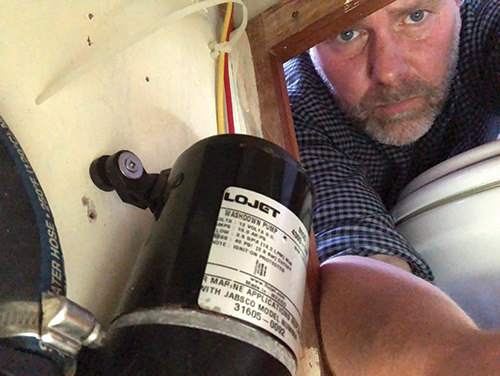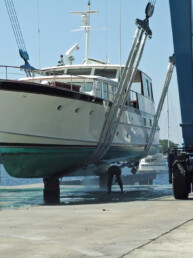
Our 1984 Passport 40, Rounder, has a deep bilge. Of course, I’ve looked down into the well at the aft end of it before and each time, my brain registered three things in quick succession.
First, “That looks gross.”
Second, “I will definitely need to do a proper cleaning of this area.”
And third, “This will be a dirty, difficult and thankless task that is best left for another day.”
I was already way behind schedule with my punchlist to prepare Rounder for what turned out to be a nearly six-week, almost 1,000-mile circumnavigation of Vancouver Island when I noticed a slurry of sticky gray gunk in an upper bilge stemming from the cleanup of a major construction project over the winter.
I worried that if some of that slurry had reached the depths of the lower bilge, it might gum up our bilge pumps. Reluctantly, I came to the conclusion that it was time to give the deep bilge a deep clean.
What I discovered when I did dumbfounded me.
On the Passport 40, just aft of the engine the bilge falls off into a deep well. From the cabin sole, that well measures 3.5 feet deep. And the only access to that section of the bilge is a small door that opens into the narrow passage between the galley counter and the navigation station.
Over the past decade of refitting our boat, I’ve been in just about every corner of the boat imaginable, always making the extra effort to ensure I inspect those corners carefully and leave them in better shape than I found them — cleaned and painted if possible.
But not this deep well in the bilge. It was literally the last place in the boat that hadn’t been given a thorough going over. It was definitely out of sight and out of mind, just the kind of place where the stuff that hits the fan during an emergency hides in wait for said fan.
I stuck my very bright LED work light into the well and looked down into the abyss. In theory, there was just a few inches of water in the bottom of that well. But it was inky black water that looked as if it might just be bottomless. I shuddered a bit at the thought.
Our boat’s first engine was a Mercedes Nanni diesel, which was notorious for oil leaks and discarded before we purchased the boat. Rounder currently has a Yanmar that hasn’t leaked a drop in more than 1,000 hours of use. But the residue of the old engine’s foibles clearly had done a number in the deep part of the bilge.
I took out a thin bronze rod and began poking around the bottom of the bilge. I expected to feel a solid, smooth bottom. What I found, though, was a layer of muck covering an uneven layer of solid stuff. What the hell was all of that?
Whatever it was, I knew I had a bigger issue than some slurry and oily sludge. If we ever needed to actually use our bilge pumps in an emergency, there was apparently a mysterious pile of debris that could clog them and lead to disaster.
I returned to the boat the next day, armed with a cheap wet/dry vacuum and our small power washer. I also grabbed several lidded 5-gallon buckets from the marina to store the wastewater from this cleaning project.
Most importantly, I had one of those 2-foot-long pickup tools that can grab items which are normally out of reach. There was simply no other way to reach the bottom of that well with my normal-length arm and the limited amount of access.
I sprayed the bottom of the well with high-pressure water, then vacuumed it out. After several rounds of this, the shape of the debris field at the bottom started to come into view. But I still couldn’t make out what I was looking at.
I had to lay on my stomach next to the access door and reach into the well with my left arm. With my shoulder wedged in the little door opening and my face squished against the side of the galley counter, I could just reach the bottom of the bilge with the grabber. Of course I couldn’t see what I was doing, so I had to work mostly by feel.
My first few forays with the grabber netted a bunch of cut zip ties. I grumbled. I’ve had to cut and replace a lot of zip ties in my time and I’m always careful to properly dispose of them. It peeved me that someone in the 20-odd years before we bought the boat thought it was okay to let these just drop down into the bilge.
I could also tell that there was much more than just zip ties down there. I just couldn’t figure out what.
Dozens and dozens of times, I got into the proper boat yoga position — which I call downward bilge idiot — to make another stab at picking up stuff.
I rooted around by feel until I scored a solid grab. Then I would carefully lift the loot from the bottom, rolling my body on its side, slowly get on my knees and then attempt to pull the item out through the little door.
What is this thing I just got hold of? Carefully up, up it came. Then finally, into the light. Oh, a pen. What the hell was someone doing waving a pen around in this area and then dropping it?
Each successful grab usually required two or three unsuccessful attempts. Often, the item would be halfway up and then fall out of the relatively weak grip of the three little metal claws of the grabber.
Oh, this one feels interesting. Hmmm. A broken screwdriver handle. And here comes a socket. A hose clamp, that makes sense. Some wire, screws, a wrench, another screwdriver. And a big chunk of glass. Glass?! How in the hell did that get down there?
I began to feel like an archeologist rooting around in some ancient trash bin.
Hour after hour, this went on. I started to unearth bigger and bigger pieces of junk, including plywood. Plywood? After puzzling on it, I figured someone must have hacked out a nonstructural area in the compartment to facilitate the engine removal and replacement.
The more stuff I found, the more I was committed to getting every last piece of junk out of that well. But I was also getting really annoyed. It’s one thing to drop something in the bilge and shrug it off occasionally; it’s another to do that over and over and over again.
Nuts, washers, a plastic knife. More plywood. An old bilge pump float switch attached to a plastic platform.
And then I discovered a round, heavy piece of metal near the back. I couldn’t fathom what it was. At first it seemed like it might be attached to the bottom. Some crazy old-style pump? But eventually it came loose. After a good 30 minutes and about a half dozen frustrating drops back into the well, I manage to extract it.
It was a prop shaft coupling. Luckily, it wasn’t the prop shaft coupling that was attached to our engine. But still. At some point, someone separated the propeller shaft from the coupling, let it drop into the bilge and then never bothered to retrieve it. They must have known it was down there. What were they thinking, that the bilge fairy would come at night, take it away and leave a few dollars under the pillow? That the water would eventually dissolve it? That it would add needed ballast down low?
At this point, I was sweaty, dirty, sore, disgusted, and mad. I was mad at the people who had worked on this boat in the past with so little care. And I was mad at myself for having ignored this potential problem for so long. It was so much worse than I had expected.
Finally, I was done. A few more sweeps of the pressure washer and about 15 gallons of wastewater later, the bilge well was debris-free and a lot cleaner.
 Relieved that this task was behind me, I drove home that night still haunted by what could have happened if I had left that mess in place. It was a reminder that on a boat, out of sight should never be out of mind. Because it is in those dark and dirty spaces where the biggest trouble lurks — and maybe a shaft coupling or two.
Relieved that this task was behind me, I drove home that night still haunted by what could have happened if I had left that mess in place. It was a reminder that on a boat, out of sight should never be out of mind. Because it is in those dark and dirty spaces where the biggest trouble lurks — and maybe a shaft coupling or two.
Marty McOmber is a Pacific Northwest sailor, writer, and strategic communications professional. He is currently working on refitting and improving his 1984 Passport 40, Rounder, for continued cruising adventures near and far.






